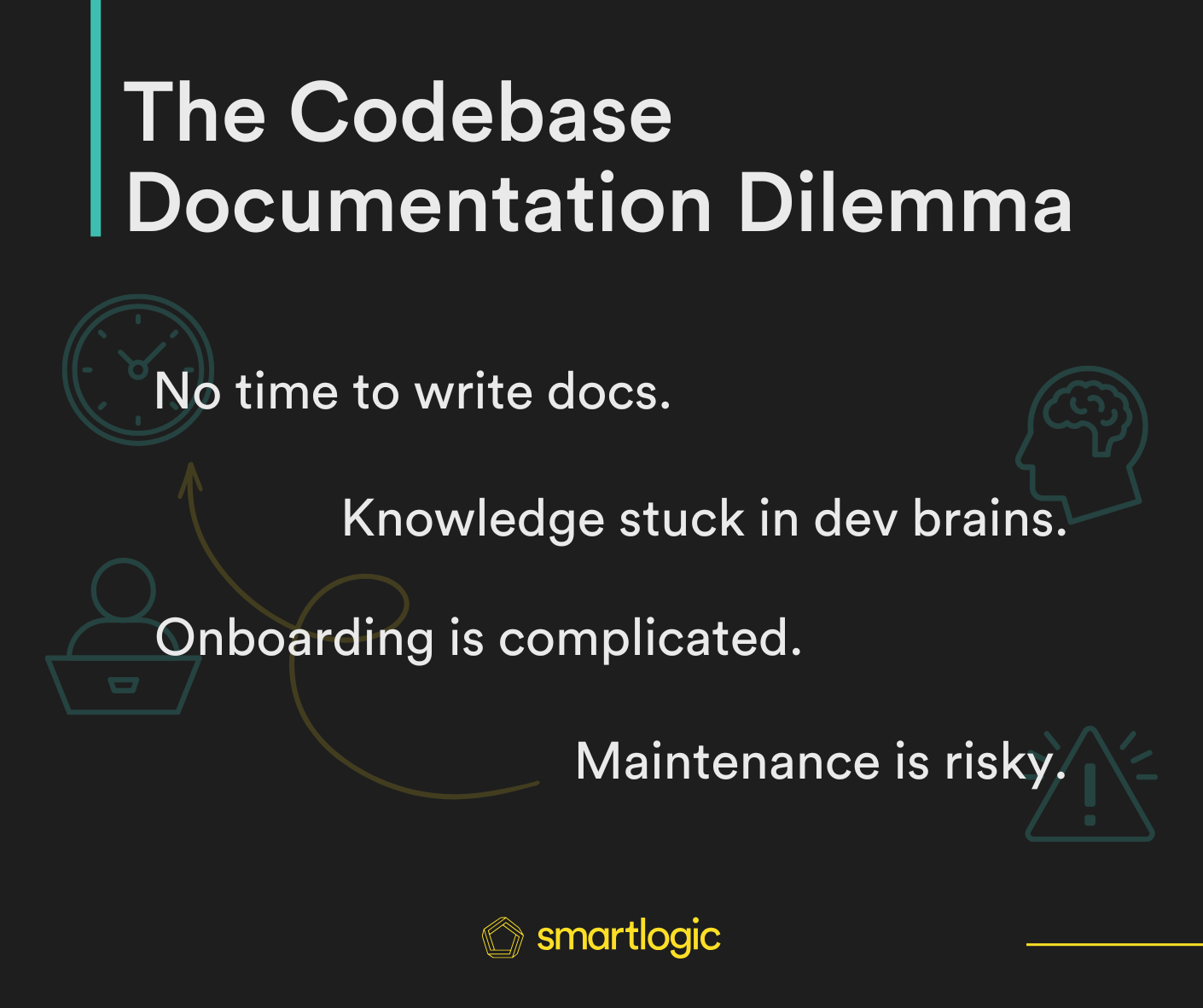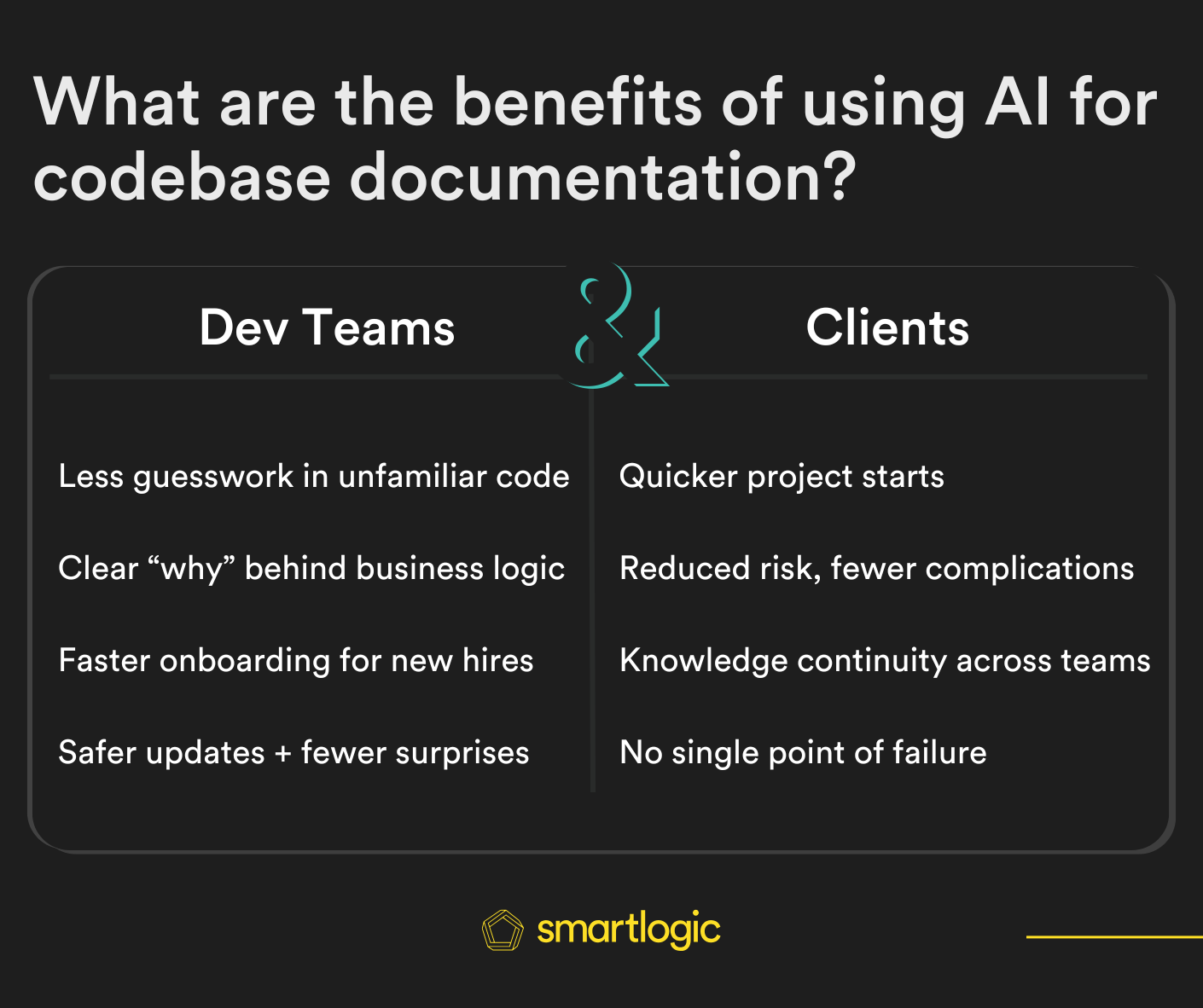How AI tools can solve the eternal problem of missing documentation and tribal knowledge
There's a universal truth in software development: the more complex your application becomes, the more likely it is that critical knowledge exists only in someone's head. New developers join the team, ask perfectly reasonable questions about how things work, and get met with uncomfortable silences.
If this scenario sounds familiar, you're not alone. Documentation is one of those things every development team knows they should have, but it's hard to justify spending time and budget on explaining existing features when that same effort could go toward building new ones. The result? Knowledge trapped in individual heads, new team members struggling to understand business logic, and that one person who becomes the unofficial keeper of the knowledge.
Here's how I used AI to tackle this problem head-on, and what it means for teams drowning in undocumented complexity.
The Documentation Dilemma
Every development team faces the same challenge: the people who built the system are busy building the next feature, and documenting what already works feels like time that could be spent on "real" work. But this creates a vicious cycle:
- New developers struggle to understand existing features and business logic
- Knowledge becomes siloed with specific team members
- Maintenance gets risky because nobody fully understands how things connect
- Onboarding takes forever as new hires hunt down the right person to explain each system
The traditional approach to solving this is to schedule "documentation sprints" or assign junior developers to write docs. But these efforts often produce documentation that's either too shallow to be useful or becomes outdated the moment the code changes.

AI-Powered Documentation: A Different Approach
Instead of trying to find time to write documentation, I decided to see if AI could analyze an existing codebase and generate the documentation we actually needed. The results were surprising.
Using AI tools with codebase access, I focused on three key areas that consistently cause onboarding headaches:
1. Business Logic Extraction
Complex applications accumulate business rules that get buried in conditionals, callbacks, and service objects. New developers can see what the code does, but understanding why it does it requires someone to explain the business context.
AI identified these patterns and explained the reasoning behind them. Instead of just documenting that a certain condition exists, it could explain scenarios like "When a user completes a specific action during a particular time window, the system automatically triggers additional processes that might not be obvious from the code alone."
2. Data Relationship Mapping
Modern applications have complex data models with relationships that aren't always obvious from the schema or ERD alone. AI helped create clear explanations of how different models interact, what the relationships mean in business terms, and when certain associations get created or updated.
This turned out to be invaluable for helping developers understand not just the technical structure, but the real-world workflows the data represents.
3. Feature Workflow Documentation
Perhaps most importantly, AI could trace through entire user workflows and document how different parts of the system work together to accomplish business goals. This kind of end-to-end documentation is exactly what new developers need but rarely gets written because it requires understanding both the technical implementation and the business requirements.
The Practical Implementation
The process was straightforward but thorough:
Comprehensive Model Documentation: AI analyzed all major models, their relationships, and their role in the business domain. This created a foundation for understanding how the application represents real-world concepts.
Feature-by-Feature Analysis: Breaking down complex features into digestible explanations of what they do, how they work, and why they exist. This included everything from goal management workflows to administrative customization options.
Permission and Access Control Mapping: One of the most complex aspects of any application - who can do what, when, and under what circumstances. AI helped create clear documentation of the permission system that both developers and stakeholders could understand.
Dead Code Identification: As a bonus, the AI analysis identified unused CSS rules, deprecated components, and placeholder tests that could be safely removed, cleaning up technical debt in the process.
What Makes AI Documentation Different
Traditional documentation often feels like an afterthought because it is one. AI-generated documentation feels different because:
It's comprehensive by default: AI doesn't get tired or skip the "obvious" parts that often trip up new developers.
It connects the dots: AI can trace relationships between distant parts of the codebase and explain how they work together.
It explains the why, not just the what: By analyzing code patterns and business logic, AI can infer and document the reasoning behind implementation decisions.
It stays current: Because it's generated from the actual codebase, it reflects the current state of the system rather than what someone remembered to update six months ago.
The Team Impact
The results are immediate and noticeable:
Faster onboarding: New developers can understand complex workflows without hunting down the right person to explain them.
Reduced knowledge silos: Critical business logic was documented outside of individual team members' heads.
Better technical discussions: Having clear documentation of existing systems made architectural discussions more productive.
Improved maintenance confidence: Developers felt more comfortable modifying code when they understood the business context behind it.
Beyond Documentation: AI as a Development Partner
This project reinforced something I'd learned from previous AI collaborations: the technology is most powerful when it amplifies human expertise rather than replacing it. AI can analyze patterns and generate comprehensive documentation, but it still requires human judgment to validate the output and ensure it captures the nuances that matter.
The real value comes from using AI to handle the systematic, thorough work that humans often skip due to time constraints, freeing up developers to focus on the strategic thinking and creative problem-solving that we do best.
What This Means for Development Teams
For teams struggling with undocumented systems, AI offers a practical solution to a persistent problem. Instead of waiting for the "right time" to document everything, you can generate comprehensive documentation from your existing codebase and iterate from there.
This is particularly valuable for:
Legacy systems where original developers have moved on
Complex business domains with intricate rules and workflows
Growing teams that need to onboard new developers quickly
Maintenance projects where understanding existing code is critical
The Consulting Advantage
At SmartLogic, this approach changes how we deliver value to clients with complex, undocumented systems. We can quickly understand and document existing codebases, reducing the risk and timeline of enhancement projects.
For our clients, this means:
Faster project starts: We can understand existing systems more quickly, reducing discovery time
Better risk management: Comprehensive documentation reduces the chance of unexpected complications
Knowledge transfer: Clients end up with documentation they can use for future development
Team continuity: Reduced dependency on specific individuals who "know how everything works"

The Bigger Picture
Documentation has always been a necessary but neglected part of software development. AI doesn't just make it easier to create documentation - it makes it possible to maintain the kind of comprehensive, current documentation that teams need but rarely have time to create.
This represents a shift in how we think about knowledge management in software projects. Instead of documentation being something we do after building features, it becomes something that happens alongside development, providing immediate value to the team.
Looking Forward
The patterns I learned apply to any complex codebase that needs better documentation:
- Automated business logic extraction for complex domains
- Real-time documentation updates as code changes
- Onboarding documentation tailored to specific roles
- Technical debt identification and cleanup guidance
As AI tools become more sophisticated, the barrier to maintaining excellent documentation continues to drop. Teams that adopt these approaches early will have a significant advantage in managing complex systems and onboarding new developers.
The Bottom Line
Undocumented systems are expensive - they slow down development, increase risk, and create unnecessary dependencies on specific team members. AI provides a practical solution that can generate the comprehensive documentation your team needs without the traditional time investment.
For teams managing complex systems, this isn't just about having better docs - it's about reducing risk, improving maintainability, and enabling faster development cycles.
Struggling with an undocumented legacy system? Let's talk about how SmartLogic can help you understand and improve your existing codebase.



